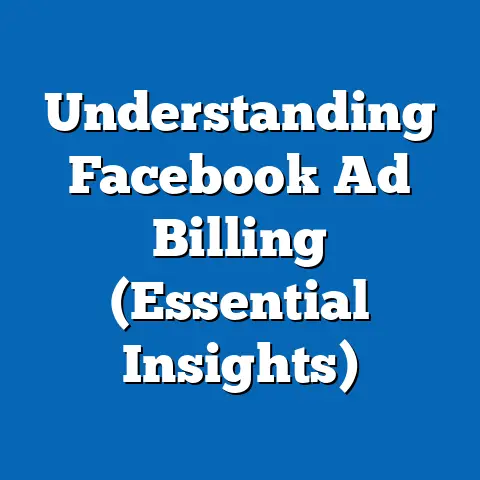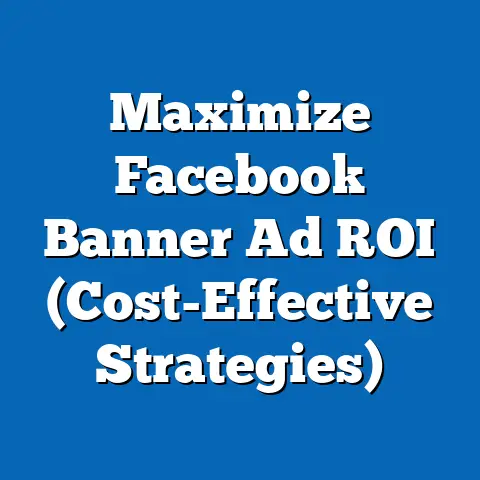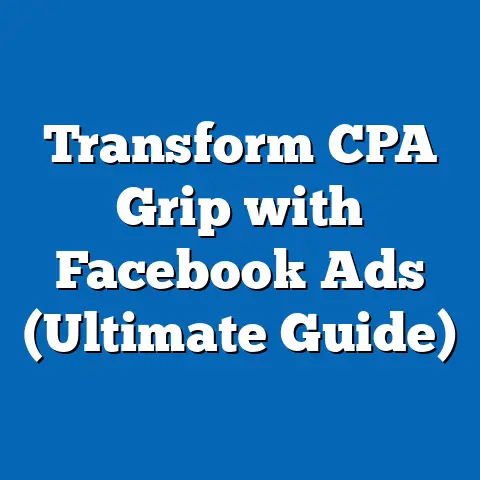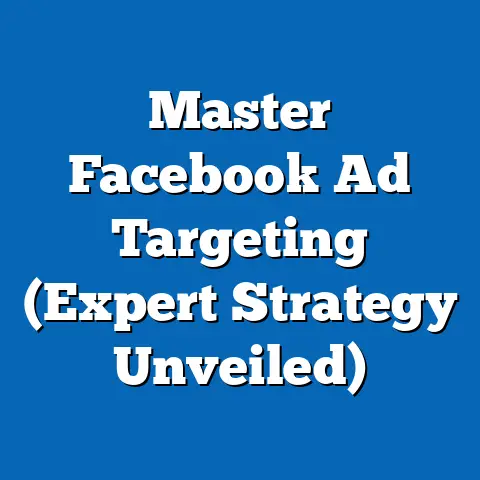Target Businesses on Facebook Ads (Proven Strategies Inside)
Imagine reaching the exact customers who are most likely to buy your product or service, cutting through the noise of the digital world with laser-like precision. That’s the promise of targeting businesses on Facebook Ads—a platform that has revolutionized how companies connect with their audiences. With over 2.9 billion monthly active users as of 2023 (Statista), Facebook remains a dominant force in digital advertising, offering unparalleled opportunities for businesses to refine their marketing strategies.
The stakes are high: businesses spent approximately $123.1 billion on social media advertising worldwide in 2022, with Facebook commanding a significant share of that investment (eMarketer). Yet, the key to success lies not just in spending but in targeting. This article dives deep into proven strategies for targeting businesses on Facebook Ads, backed by data, trends, and actionable insights to help you maximize your return on investment (ROI).
The Evolution of Facebook Ads: From Broad Reach to Hyper-Targeting
A Brief History of Facebook Advertising
Facebook launched its advertising platform in 2007 with a rudimentary system that allowed businesses to create basic ads. Initially, the focus was on broad demographic targeting, such as age and location, with limited customization. By 2012, the introduction of Custom Audiences marked a turning point, enabling advertisers to upload customer lists for more precise targeting.
Fast forward to 2023, and Facebook Ads has evolved into a sophisticated ecosystem with tools like Lookalike Audiences, Detailed Targeting, and the Ads Manager platform. According to Hootsuite’s 2023 Digital Report, 78% of businesses now use social media advertising, with Facebook being the top platform for B2B and B2C targeting. This shift from broad reach to hyper-targeting reflects a growing demand for personalized marketing.
Current Trends in Facebook Ads Spending
Spending on Facebook Ads continues to grow, with businesses in the United States alone investing over $50 billion annually as of 2022 (Statista). Small and medium-sized enterprises (SMEs) account for a significant portion of this spending, with 44% of SMEs using Facebook Ads to reach local and niche markets (HubSpot). Meanwhile, larger corporations leverage the platform for global campaigns, often combining organic content with paid ads for maximum impact.
A notable trend is the increasing focus on video ads, which saw a 25% year-over-year growth in impressions in 2022 (Social Media Examiner). This suggests that businesses are adapting to user preferences, as 54% of Facebook users report watching videos on the platform daily (Pew Research Center). Understanding these trends is crucial for crafting effective targeting strategies.
Demographic Insights: Who’s on Facebook?
Facebook’s user base is diverse, spanning multiple age groups, geographies, and interests. As of 2023, 69% of U.S. adults use Facebook, with the 25-34 age group being the most active at 31% of total users (Pew Research Center). Gender distribution is nearly even, with 51% female and 49% male users, providing a balanced audience for businesses.
For B2B targeting, LinkedIn might seem like the obvious choice, but Facebook’s scale offers unique advantages. Approximately 74% of business decision-makers have a personal Facebook account, and 59% use it to research products or services (Hootsuite). Geographically, urban users dominate at 62%, compared to 38% in rural areas, which can influence location-based targeting decisions (Statista).
These demographic patterns highlight the importance of tailoring your ads to specific segments. Whether you’re targeting young entrepreneurs or seasoned executives, understanding who’s on Facebook is the first step to building a successful campaign.
Why Targeting Matters: The Data Behind Precision Advertising
The Cost of Poor Targeting
Ineffective targeting can be costly. A 2022 study by WordStream found that businesses with poorly targeted Facebook Ads have an average cost-per-click (CPC) of $1.72, compared to $0.94 for well-targeted campaigns—a difference of nearly 83%. Moreover, irrelevant ads lead to lower engagement rates, with click-through rates (CTR) dropping to 0.5% for untargeted campaigns versus 2.5% for optimized ones.
Poor targeting also risks alienating potential customers. According to a 2021 survey by Sprout Social, 66% of consumers unfollow brands on social media due to irrelevant content. This underscores the need for precision in identifying and reaching the right audience.
The Benefits of Effective Targeting
On the flip side, effective targeting yields impressive results. Businesses using advanced targeting options on Facebook report a 26% increase in conversion rates and a 20% reduction in customer acquisition costs (Facebook Business Insights, 2022). For B2B companies, targeting decision-makers through job titles and industries can result in a 35% higher lead quality compared to broad campaigns (HubSpot).
Moreover, targeted ads improve user experience by delivering relevant content. A 2023 Nielsen report found that 74% of consumers are more likely to engage with ads tailored to their interests. This creates a win-win scenario for businesses and users alike.
Methodology Behind Targeting Data
The data cited here comes from reputable sources like Statista, Pew Research Center, and industry reports from Hootsuite and HubSpot. These organizations use a mix of surveys, user analytics, and advertiser feedback to compile their findings. For instance, Statista’s ad spending figures are based on aggregated data from global marketing budgets, while Pew Research conducts annual surveys of social media usage among representative samples of U.S. adults.
Understanding the methodology ensures the reliability of the insights. As we move into specific strategies, keep in mind that data-driven decisions are the backbone of successful targeting on Facebook Ads.
Core Strategies for Targeting Businesses on Facebook Ads
1. Leverage Detailed Targeting Options
Facebook’s Detailed Targeting feature allows businesses to narrow their audience based on demographics, interests, and behaviors. For example, you can target users by job title, industry, or company size—ideal for B2B campaigns. A 2022 study by Social Media Examiner found that 68% of advertisers using Detailed Targeting saw a 15% improvement in ad relevance scores.
To apply this, start by identifying your ideal customer profile. If you’re a software company targeting small business owners, select interests like “entrepreneurship” or behaviors such as “small business owner.” Combine this with location targeting to focus on specific regions where your target audience operates.
Be cautious of overly narrow targeting, as it can limit reach. Facebook recommends keeping audience sizes between 500,000 and 1 million for optimal results. Experiment with different combinations to find the sweet spot for your campaign.
2. Utilize Custom Audiences for Retargeting
Custom Audiences let you target users who have already interacted with your business, such as website visitors or email subscribers. According to Facebook, ads targeted at Custom Audiences achieve a 70% higher conversion rate compared to cold audiences. This is particularly effective for businesses with existing customer data.
To create a Custom Audience, upload a list of email addresses or phone numbers to Facebook Ads Manager. Alternatively, use the Facebook Pixel to track website visitors and retarget them with relevant ads. For instance, a B2B SaaS company might retarget users who visited their pricing page but didn’t convert, offering a limited-time discount to nudge them toward a purchase.
The key is relevance. Ensure your retargeting ads address the specific pain points or interests of the audience segment. A 2021 report by WordStream noted that personalized retargeting ads increase CTR by 40%.
3. Build Lookalike Audiences for Expansion
Lookalike Audiences help you reach new users who share characteristics with your best customers. By analyzing a source audience (e.g., past buyers or email subscribers), Facebook identifies similar users based on demographics and behaviors. Businesses using Lookalike Audiences report a 30% lower cost-per-acquisition (CPA) compared to broad targeting (Facebook Business, 2022).
Start by creating a Custom Audience as the source, then generate a Lookalike Audience in Ads Manager. You can adjust the similarity range from 1% (most similar) to 10% (broader reach). For B2B campaigns, a smaller range often works better to maintain relevance among niche audiences like industry professionals.
Test multiple Lookalike Audiences to identify which performs best. Combine this strategy with compelling creative to capture attention, as first impressions matter when reaching new prospects.
4. Focus on Behavioral Targeting for Intent
Behavioral targeting focuses on user actions, such as purchase history, device usage, or engagement with specific content. For businesses, targeting based on “business purchase behavior” or “engaged with business content” can yield high-intent leads. A 2023 Hootsuite report found that behavioral targeting improves ad engagement by 22% compared to demographic-only targeting.
For example, a company selling office supplies might target users who have recently purchased business software or engaged with B2B pages. Layer this with job title targeting (e.g., “office manager”) to refine the audience further. This approach ensures your ads reach users with a demonstrated interest in business-related products or services.
Monitor performance metrics like CTR and conversion rate to assess the effectiveness of behavioral targeting. Adjust your criteria based on data to continuously optimize results.
5. Optimize for Mobile and Video Content
With 98.5% of Facebook users accessing the platform via mobile devices (Statista, 2023), mobile optimization is non-negotiable. Additionally, video content dominates engagement, with video ads achieving 6.09% higher CTR than image ads (WordStream, 2022). For businesses targeting other businesses, short explainer videos or testimonials can be particularly effective.
Design ads with mobile-first principles: use vertical formats (9:16), include captions (as 85% of videos are watched without sound, per Digiday), and ensure fast load times. Test different video lengths, but keep in mind that 60% of viewers drop off after 30 seconds (HubSpot).
For B2B audiences, focus on value-driven content. Highlight how your product solves a specific business problem, and include a clear call-to-action (CTA) to drive conversions.
Demographic and Industry-Specific Targeting Tips
Targeting by Industry
Different industries require tailored approaches on Facebook Ads. For tech companies, targeting by job titles like “IT manager” or interests in “cloud computing” can yield high-quality leads. A 2022 HubSpot report found that tech-focused B2B campaigns on Facebook achieve a 28% higher lead-to-close rate when targeting specific job functions.
For industries like retail or hospitality, focus on local businesses by combining location targeting with interests like “small business owner” or “retail management.” Layering these criteria ensures relevance while maintaining a manageable audience size.
Age and Gender Considerations
While B2B targeting often prioritizes job roles over personal demographics, age and gender can still play a role. For instance, younger decision-makers (25-34) are more likely to engage with innovative tech solutions, while older executives (45-54) may prioritize reliability and cost-effectiveness (Pew Research Center, 2023).
Gender differences are less pronounced in B2B, but certain industries—like beauty or wellness—may see skewed engagement. Test campaigns with and without gender targeting to determine if it impacts performance for your specific niche.
Geographic Targeting for Local Impact
Location targeting is critical for businesses serving specific regions. According to Statista, 62% of Facebook users are in urban areas, making city-specific targeting effective for localized campaigns. Use radius targeting (e.g., 10 miles around a city center) to reach nearby businesses, or target by country for broader B2B outreach.
For example, a catering company targeting corporate clients might focus on business districts in major cities like New York or Chicago. Monitor geographic performance data in Ads Manager to identify high-performing regions and allocate budget accordingly.
Historical Trends vs. Current Data: What’s Changed in Targeting?
Historical Targeting Challenges
In the early days of Facebook Ads (2007-2012), targeting was limited to basic demographics like age, gender, and location. Advertisers struggled with low relevance, as ads often reached uninterested users. Average CTRs hovered around 0.05% in 2010, reflecting the inefficacy of broad campaigns (WordStream Historical Data).
Privacy concerns also shaped the landscape. The 2018 Cambridge Analytica scandal led to stricter data usage policies, forcing businesses to adapt to reduced access to third-party data. This shift pushed advertisers toward first-party data strategies like Custom Audiences.
Current Targeting Capabilities
Today, targeting is far more sophisticated. The introduction of machine learning algorithms in Facebook’s ad delivery system has improved ad relevance, with average CTRs reaching 1.35% in 2023 (WordStream). Tools like Lookalike Audiences and behavioral targeting allow for unprecedented precision.
However, challenges remain. Apple’s iOS 14.5 update in 2021, which introduced App Tracking Transparency (ATT), reduced tracking capabilities, impacting ad personalization. Facebook reported a $10 billion revenue loss in 2022 due to these changes (CNN Business). Businesses must now rely on creative strategies and on-platform data to maintain targeting accuracy.
Future Outlook
Looking ahead, privacy regulations like GDPR and CCPA will continue to shape targeting practices. Experts predict a 15% increase in first-party data usage by 2025 as businesses adapt to a cookieless future (eMarketer). For now, mastering current tools and focusing on user consent will keep your campaigns compliant and effective.
Data Visualization Description: Understanding Audience Insights
To illustrate the impact of targeting, imagine a bar chart comparing CTRs across different strategies. On the X-axis, you’d see categories like “Broad Targeting,” “Detailed Targeting,” “Custom Audiences,” and “Lookalike Audiences.” On the Y-axis, CTR percentages range from 0% to 3%.
Broad Targeting shows a bar at 0.5%, reflecting low engagement. Detailed Targeting rises to 1.5%, while Custom Audiences hit 2.0%. Lookalike Audiences peak at 2.5%, demonstrating their effectiveness in reaching high-intent users. This visual would highlight the tangible benefits of precision targeting, making the data accessible at a glance.
A second visualization could be a pie chart showing audience demographics by age group. The largest slice, at 31%, represents the 25-34 age group, followed by 35-44 at 26%, and 18-24 at 20%. This breakdown reinforces the importance of tailoring campaigns to dominant user segments on Facebook.
Case Studies: Real-World Success with Targeting
Case Study 1: B2B SaaS Company Boosts Leads by 40%
A mid-sized SaaS company offering project management software struggled with low lead quality using broad Facebook Ads. By implementing Custom Audiences based on website visitors and layering job title targeting (e.g., “project manager”), they saw a 40% increase in qualified leads within three months (HubSpot Case Study, 2022). Their CPA dropped from $25 to $15, proving the value of retargeting high-intent users.
Case Study 2: Local Retailer Expands Reach with Lookalike Audiences
A local office supply retailer used Lookalike Audiences to target businesses similar to their existing customers. Combining this with a 10-mile radius targeting around their store, they achieved a 30% increase in in-store visits and a 22% higher ad engagement rate (Facebook Success Stories, 2023). This demonstrates how small businesses can leverage advanced tools for localized impact.
These examples show that targeting isn’t a one-size-fits-all approach. Tailoring strategies to your business model and audience is essential for measurable results.
Challenges and Pitfalls in Targeting on Facebook Ads
Privacy and Data Restrictions
As mentioned earlier, privacy updates like iOS 14.5 have limited tracking capabilities, reducing the accuracy of interest-based targeting. A 2022 survey by eMarketer found that 48% of advertisers reported lower ad performance post-ATT. To mitigate this, focus on first-party data and encourage users to opt into tracking through value-driven incentives.
Audience Fatigue
Over-targeting can lead to audience fatigue, where users see the same ad too often and disengage. According to Sprout Social, 38% of users report ad fatigue after seeing the same content more than five times. Use frequency capping in Ads Manager to limit impressions per user, and refresh creative regularly to maintain interest.
Budget Misallocation
Small businesses often struggle with budget allocation, spending too much on underperforming audiences. A 2023 WordStream report found that 55% of SMEs overspend on broad campaigns due to lack of data analysis. Regularly review performance metrics and shift budget to high-performing segments to avoid wasted spend.
Broader Implications and Future Trends
Looking to the future, expect continued evolution in targeting capabilities. Artificial intelligence (AI) will play a larger role, with Facebook’s algorithms becoming even better at predicting user behavior. A 2023 Gartner report predicts that AI-driven ad platforms will increase targeting accuracy by 30% by 2026. Meanwhile, privacy will remain a central concern, pushing businesses to prioritize transparency and user consent.
For now, the key takeaway is clear: precision targeting isn’t just a tactic; it’s a necessity in the competitive world of digital advertising. By leveraging data, testing strategies, and adapting to trends, businesses can unlock the full potential of Facebook Ads to reach the right audience at the right time.
Whether you’re a small business owner or a marketing professional at a large corporation, the principles remain the same. Start with a deep understanding of your audience, use the tools at your disposal, and let data guide your decisions. The numbers don’t lie—targeting works, and with the right approach, it can transform your business.






